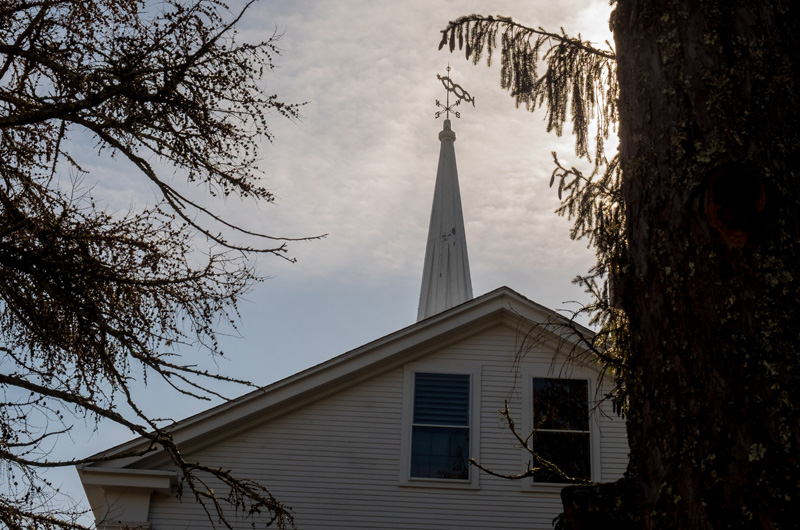The steeple on the Tisbury town hall is structurally compromised and in possible danger of collapse, town officials confirmed this week.
Originally a church, the town hall was completed in 1844 in classic New England style. Today it houses both town offices on the lower floors and the Katharine Cornell Theatre on the second floor. Increasingly though, the building resembles the iconic piece of Italian architecture, the tower of Pisa.
The steeple is listing toward the building six to eight inches, according to Tisbury facilities manager Kirk Metell, and that’s when there’s no wind.
“If you look at the building itself, you can see where the steeple is straining the roof,” Mr. Metell told the Gazette by phone this week. “If it does collapse, it could be dangerous.”
Mr. Metell wrote a historic preservation application for funding from the Community Preservation Committee to repair the steeple last fall.
“The steeple has moved/shifted on its support beams and is at risk of toppling,” the application reads. The steeple is constructed entirely from wood. Much of the damage is due to insect rot.
The church was originally one story, but sometime in the late 1800s, the building was raised up to create a second floor beneath the original one. The new first floor was used to house town offices and the fire department. In 1920, the town bought the property from retired whaling captain Gilbert L. Smith, who had also been a selectman. In 1971, the building underwent extensive restoration funded by a gift from the Peter C. Cornell trust.
Mr. Metell said repairs have been delayed and pushed off, but the issue is becoming urgent.
Town administrator John (Jay) Grande said the structural issues began to become evident when the town restored the weathervane that sits on top of the building in 2008.
“We had a crane come in for the weathervane, and when we went to secure it, that’s when the questions about the structural integrity of the steeple came up. That led to closer scrutiny of steeple in general,” he said.
In 2016, the town hired Vineyard Haven structural engineer John Lolley to evaluate the building. Among other inspections, he used laser beams to measure the lean, which then was between four and six inches.
“Those types of deflections are typical for that type of construction because the front is supported by outside wall of the building. As you get further away from the wall, the building gets weaker,” Mr. Lolley said.
The report also identifies rotting from leaks in the roof. Mr. Lolley said some of the many repairs done to the structure over the decades have done more harm than good.
Fixing the problem will be no small feat.
“Repairing the existing one would cost just as much, if not more, than replacing the steeple altogether,” said Mr. Metell.
Mr. Lolley recommended using a crane to remove the existing steeple and salvaging the weathervane. Next he recommended constructing an entirely new identical steeple off-Island, breaking it down into three parts, and shipping it back by ferry to be reconstructed in Vineyard Haven. It would be lifted onto a new steel frame, again using a crane.
“You obviously can’t have people working in here when that’s going on,” Mr. Grande said. “There’s a lot of logistical planning that will be necessary.”
Repairs to the steeple are projected to cost half a million dollars. The town has earmarked $200,000 in Community Preservation Act funds for the project, pending approval at town meeting and approval from voters to cover the remainder of the projected costs.
The expensive steeple repairs come at a time when the town is facing other large capital expenditures, including an estimated $50 million elementary school construction project, about $30 million of which would come from the town.
“We’ve known about the steeple for years now, but we have a lot on our plate this year with the school,” said selectman Tristan Israel this week.
The town also expects to bring a request before voters for $675,000 to buy property at 55 West William street to eventually build a new town hall altogether.
Depending on availability of funding, Mr. Metell said the town may be forced to remove the existing steeple before they can afford to replace it with another one, leaving the historic building temporarily decapitated.
Mr. Metell said he would prefer the work to be done some time in the following year.
“Safety-wise, we at least need to take the steeple off,” he said.
Mr. Lolley was more hesitant to say the “collapse” word.
“If you don’t have a storm for the next 50 years, it will be fine,” he said.






Comments (1)
Comments
Comment policy »